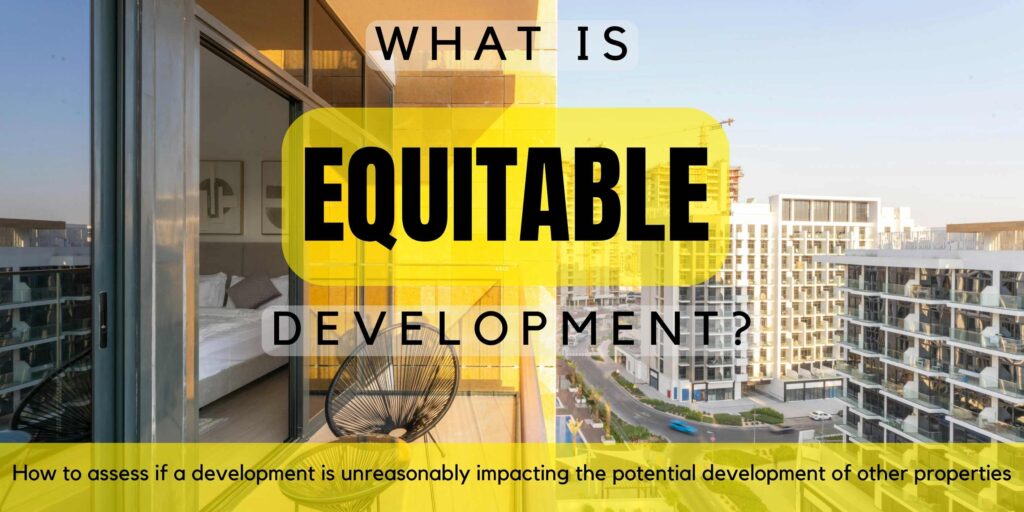04 Sep Equitable Development Principles

In a recent project of ours the idea of equitable development has arisen. Equitable development is the concept of not unreasonably impacting on the development potential of other properties. It is more likely to be considered in areas where a high level of development and change is anticipated. Many recent proposals where equitable development has been considered have been high rise developments in the city or within activity centres.

In a broad sense it makes sense. Councils don’t want one development to constrain the ability of other surrounding sites from also being able to be developed, otherwise the housing capacity for the area could be severely compromised. If the idea of “first in first served” is adhered to with abandon, the overall development of an area could be severely compromised. Without a doubt there have been numerous developments approved in the past that have then compromised the development of adjacent land. Consideration of equitable development will at least go some way to limit this in the future.
In practice, assessing what is equitable in development is quite complicated. As has been shown in various VCAT decisions, there are no set prescriptive measures that define equitable development. Rather it is based on an assessment on the individual merit of an application.
Numerous decisions at the Tribunal have considered equitable development rights. A number of principles have emerged and are summarised in Gesher Pty Ltd v Yarra CC [2015] VCAT 506 (21 April 2015) as follows.
Principles of Equitable Development
- Equitable does not mean equal
- Development should not be too dependent on borrowing from neighbouring sites for its amenity
- In the absense of a specific proposal for an adjoining property, development should not have to satisfy a speculative or hypothetical worst case scenario on an adjoining property.
- The site size, proportion and context will influence how amenity can be equitably shared between adjoining sites.

Amenity
The main consideration for equitable development relates to amenity, amenity of both future developments as well as the current proposal.
Off-site Amenity
Firstly, how will the proposal impact on the amenity of a reasonable future development on an adjacent site. Will the height, form, setbacks etc allow for an adjacent site to be developed in the future without impacting on their amenity? Or will the proposal compromise the amenity of a future development on an adjacent site. A key phrase here is “reasonable future development”. Decision makers should limit themselves to only consider the type of development that is realistic for the site. An example of this could be in determining the likely height of a future development. If the planning controls recommend a maximum height of 18m, then it would not be reasonable to account for future development going above or under that height in most circumstances.
As mentioned before this approach is generally only relevant in areas where a high level of development is being encouraged. In this way, there can be a high level of confidence that a development on another site is a likely proposition. In areas where only some development is being allowed, and therefore many sites will not be developed, the principles of equitable development don’t make sense.
Internal Amenity
The second area of amenity to be considered is if the internal amenity of the proposed development will be impacted on by surrounding future developments. This would occur if the proposal relied unreasonably on adjoining properties in order to achieve satisfactory internal amenity. For example if a proposal relied on adjoining land for adequate daylight and outlook to windows, and the amenity of these rooms would then be severely compromised if that adjoining site was developed.
Setback “Rules”
The consideration of equitable development can also take the form of a “rule of thumb” that developments should be setback 4.5m from side/rear boundaries. The thought behind this rule is to limit overlooking. If both developments on a common boundary did this, it would create a 9m separation and allow for reasonable outlook on both sides without screening. In reality this is a simplistic design response that has little real-life application. It doesn’t take into account locations where the narrowness of sites makes such a setback unreasonable and doesn’t account for alternative solutions to equitable development that may be more appropriate. It doesn’t pass the first principle discussed above as equitable does not mean equal.
The principles of equitable development is only one of many considerations for higher density development. As it can involves a certain level of guesswork (in the form of considering a future development that does not yet exist even in conceptual form), blanket rules should be avoided. It should not be used to unduly constrain reasonable levels of development. Instead it should safeguard against future development being compromised, so that an area can be developed to the potential envisaged by the strategic direction for the area.
Planning an apartment building on your site and needing advice if equitable development principles or other planning controls should be considered? Contact us today for a complimentary initial chat!

